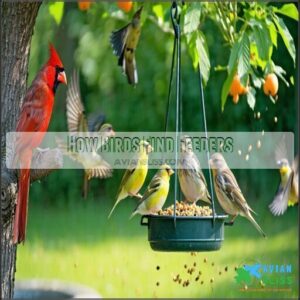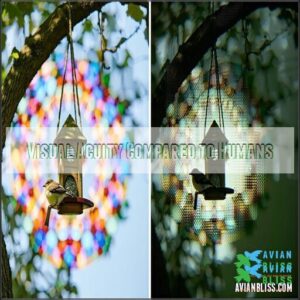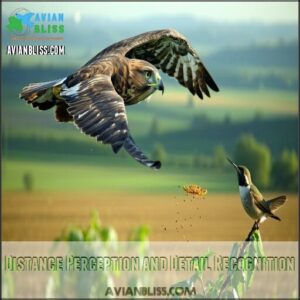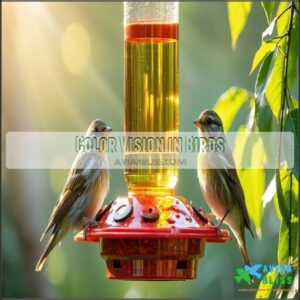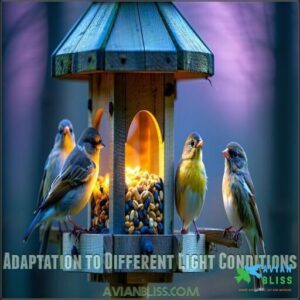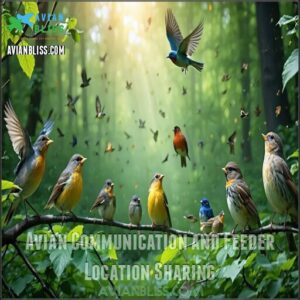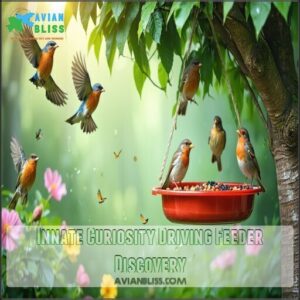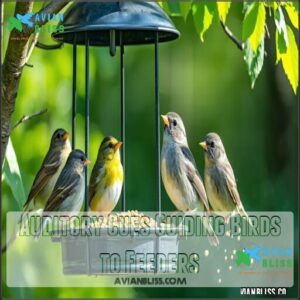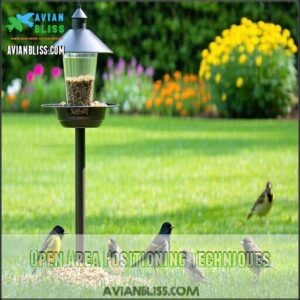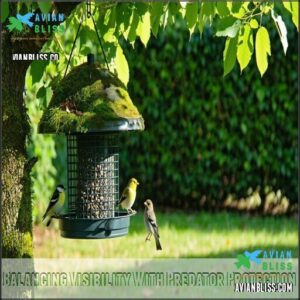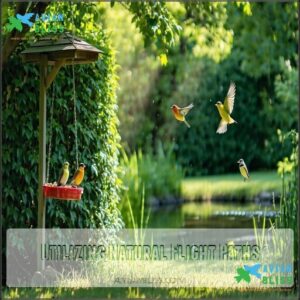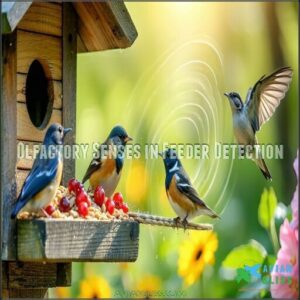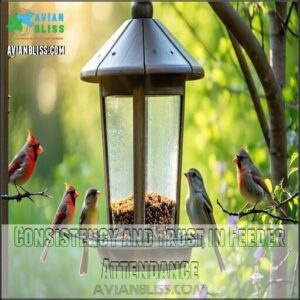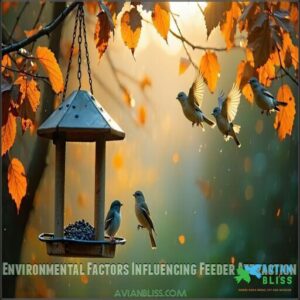This site is supported by our readers. We may earn a commission, at no cost to you, if you purchase through links.
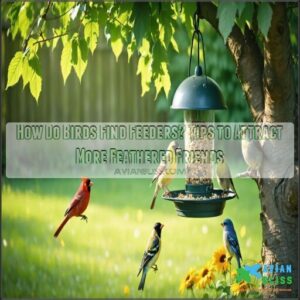
Their vision is designed to spot movement and color, making bright feeders or sunflower seeds stand out like a neon sign.
They also listen for the calls of other birds, which can act like nature’s gossip network, leading them to food.
Memory plays a role too—many birds remember past food sources and return for more.
Curiosity drives them to explore new areas, so don’t be surprised if they investigate your yard.
With the right setup, you’ll have feathered guests flocking in no time, and be ready to impress them with your yard.
Table Of Contents
- Key Takeaways
- How Birds Find Feeders
- Birds’ Exceptional Eyesight for Locating Feeders
- Avian Communication and Feeder Location Sharing
- Memory and Spatial Recognition in Birds
- Innate Curiosity Driving Feeder Discovery
- Auditory Cues Guiding Birds to Feeders
- Strategic Feeder Placement for Maximum Visibility
- Olfactory Senses in Feeder Detection
- Consistency and Trust in Feeder Attendance
- Environmental Factors Influencing Feeder Attraction
- Frequently Asked Questions (FAQs)
- What type of bird feeders are best for attracting birds?
- Where can I buy bird feeders?
- What are the different types of bird feeders?
- What is the best bird feeder for my garden?
- How do birds know to find bird feeders?
- How do birds find bird feeders so fast?
- Do birds remember where feeders are?
- How long does it take for birds to find a feeder?
- How do you let birds know you have a feeder?
- How do birds recognize bird feeders?
- Conclusion
Key Takeaways
- Place feeders in open, visible spots with bright colors like red or yellow to catch birds’ attention and make them easier to spot.
- Keep feeders stocked with high-quality food like black oil sunflower seeds and maintain a consistent feeding schedule to build bird trust.
- Position feeders near shrubs or trees for safety, allowing birds quick escape routes from predators.
- Birds use their sharp eyesight, memory, and social cues from other birds to quickly locate and remember feeder locations.
How Birds Find Feeders
Birds discover feeders using their sharp eyesight, innate curiosity, and social behaviors.
Birds use sharp vision, natural curiosity, and social signals to turn feeders into trusted food hubs.
With exceptional bird vision, they can spot movement, bright colors, or seed scattered near feeders from remarkable distances. Feeder discovery rate improves if you place feeders in open spaces with nearby shrubs or trees for safety.
Choosing novel feeder designs or bright colors, like red or yellow, boosts feeder color attraction, especially for fruit-loving species. Birds follow a species learning curve—they may take time to notice feeders but spread the word through calls or flock activity once found.
In urban areas, urban bird feeders are highly effective when placed visibly and stocked with quality seed types. To further entice birds, consider offering a clean birdbath near the feeder. A well-placed, accessible feeder location makes more consistent bird visits over time.
Birds’ Exceptional Eyesight for Locating Feeders
Birds’ vision is remarkably sharp, letting them notice small details like seeds or feeder shapes from impressive distances.
Their ability to see vibrant colors and perceive depth helps them quickly spot food, even in low light or crowded environments, which is a key factor in their survival, thanks to their ability to see small details.
Visual Acuity Compared to Humans
Seeing the world through bird vision is like watching a high-definition nature documentary every day.
With their unique avian eyes, birds experience astonishing visual detail thanks to specialized adaptations.
Here’s why bird sight surpasses human vision:
- Color perception: Birds see ultraviolet light, uncovering patterns we can’t imagine.
- Refraction power: Birds adjust their eye structure, like focusing binoculars, for sharpness.
- Dim light adaptation: Their eyes pick up details in low light, ensuring they spot food anytime.
Their proportionally larger avian eye size provides incredible clarity, making bird vision a superpower for survival and feeder detection!
Distance Perception and Detail Recognition
Spotting feeders from afar showcases the incredible precision of avian eyes.
Their depth perception and keen eyesight pick up motion and details that would elude most humans. It’s like their vision has built-in zoom and autofocus.
Hawks can spot a rodent 2 miles away, while sparrows see seeds from half a mile. Even hummingbirds, with sharp detail memory, recognize flowers from 0.25 miles.
| Bird | Distance Seen | Detail Recognized |
|---|---|---|
| Hawk | 2 miles | Small rodents |
| Sparrow | 0.5 miles | Seeds |
| Hummingbird | 0.25 miles | Nectar sources |
Avian vision guarantees every detail counts.
Color Vision in Birds
Birds have incredible color perception, making your feeder’s appearance essential. Unlike humans, they’ve got four types of cones in their eyes, giving them UV vision and an enhanced “bird’s eye view” of the world.
This sharper vision lets them spot colors and patterns we can’t see, like ultraviolet markings on fruits or reflective surfaces. Bright reds and yellows scream “food here,” especially for hummingbirds and orioles, who instinctively favor these hues.
It’s why many feeders shine with bold, vibrant colors—they’re practically flashing neon signs for birds! To attract more feathered visitors, choose a feeder with bold colors or unique shapes. Consider reflective finishes too—birds interpret these as signals of food nearby, tapping into their advanced bird vision capabilities to find feeders fast.
Adaptation to Different Light Conditions
In the context of spotting feeders at dawn or dusk, birds rely on their extraordinary vision built for adapting to changing light.
While human eyes might struggle in low light, birds excel thanks to their UV vision and light-reflecting adaptations.
In tricky conditions, birds use these abilities:
- UV vision reveals patterns and reflections invisible to us.
- Color perception adjusts dynamically, enhancing visibility in dim light.
- Light polarization aids in reducing glare and tracking shadows.
Even during nocturnal feeding, their eyesight effortlessly switches to detect subtle contrasts. This remarkable ability makes certain they can locate food, even when the world appears dim and shadowy to us.
Avian Communication and Feeder Location Sharing
Birds rely on a mix of vocal signals, visual cues, and flock behaviors to share feeder locations.
By observing and responding to these forms of communication, they create a network that helps others quickly find food.
Species-specific Calls and Sounds
Birds don’t just rely on sight to find feeders; they use their sharp hearing and sophisticated communication skills too.
Their calls and songs act like a group chat, sharing updates about food, predators, or flock locations. This “bird radio” lets them stay connected over long distances.
You can often hear them broadcasting:
- Alarm signals: High-pitched warnings when predators are near.
- Food vocalizations: Excited squawks to announce a newfound feast.
- Mimicry learning: Calls repeated by others, helping spread the message.
- Soft contact chirps: Gentle sounds to maintain flock cohesion.
These bird calls reflect fascinating adaptations, like species-specific dialects that evolve over time.
Listening to these auditory signals offers a front-row seat to their behavior, adding depth to understanding their feeder-finding strategies.
Visual Cues and Body Language
Bird communication isn’t just songs; they also rely on body language.
Subtle actions like wing signals, head movements, or posture communication share food details.
Feeder coloration and shape recognition improve bird feeder visibility, helping them interpret these cues.
For example, a quick feather puff shows safety, while sharp head tilts signal excitement.
Here’s a breakdown to enhance visibility:
| Cue | Meaning | Example Behavior |
|---|---|---|
| Wing Signals | Attraction | Quick wing flick |
| Head Movements | Discovery excitement | Rapid peck directions |
| Posture Communication | Safety or trust | Feather fluffing |
Birds notice every detail!
Flock Behavior and Information Transfer
When one bird discovers your feeder, it often kickstarts a neighborhood-wide event that draws in their feathered friends.
Birds thrive on flocking benefits, using communication signals like calls and movements to share the news. This creates a ripple effect of arrivals as the flock embraces social learning. Simple local interactions drive this collective movement.
- Local enhancement means one bird’s activity attracts nearby species.
- Community knowledge quickly spreads food locations through natural bird communication networks.
- Species interactions within mixed flocks boost discovery, transforming your feeder into a hub of activity.
This teamwork highlights the magic of bird behavior and shared wisdom.
Social Learning Among Bird Species
When birds gather, their flock dynamics become a powerful tool for finding feeders, thanks to social learning.
Birds observe and imitate both flockmates and other species, creating a ripple effect.
Here’s how it works:
- Observational Learning: Birds watch others eating, spurring curiosity.
- Mimicry Learning: Younger birds follow experienced ones.
- Inter-species Learning: Mixed groups share knowledge.
- Cultural Transmission: Feeding habits spread quickly.
- Memory Influence: Feeders are remembered season to season.
It’s teamwork in action!
Memory and Spatial Recognition in Birds
You’d be amazed at how birds use their memory to keep track of reliable food sources like feeders.
They create mental maps, relying on landmarks and seasonal patterns to revisit locations year after year.
Cognitive Mapping of Food Sources
Your yard is like a GPS system for birds, thanks to their Mental Bird Maps. With sharp Spatial Memory and remarkable Cognitive Abilities, birds rely on nearby landmarks—trees, fences, or even garden furniture—for bird feeder navigation.
This advanced bird memory supports efficient foraging strategies, ensuring they return to familiar feeders. Move feeders too often, though, and you’ll disrupt their route optimization.
Keeping feeders in stable locations helps birds build reliable mental maps. So, if you’re keen to enjoy regular visits, stick with consistency—it’s the key to supporting their impressive navigation skills and making your yard their trusted stop.
Long-term Memory for Feeder Locations
Think of a bird’s mind as a built-in GPS, effortlessly locking in feeder spots.
Feeder site fidelity comes from recognizing patterns, building trust in consistent food sources.
Reliable bird feeders quickly become favorites, etching their location into long-term memory.
Generational feeder knowledge also develops, as birds return to places their ancestors trusted.
By maintaining a learned feeding schedule, you’re helping birds navigate directly to their dependable dining spot, which is a result of long-term memory.
Landmark-based Navigation
Birds are like skilled travelers, mapping their surroundings with remarkable precision. They use environmental landmarks—trees, fences, and bushes—to store detailed mental pictures, helping them locate feeders repeatedly. With their incredible spatial memory, they focus on recognizable shapes, colors, and patterns to build cognitive maps of your yard.
Circling above? That’s not random—it’s route learning in action. They scan for visual cues, like a brightly colored feeder near a favorite perch, embedding details into their memory.
To assist bird navigation and behavior:
- Place feeders near natural markers like shrubs and trees.
- Use brightly colored feeders for stronger visual impact.
- Position feeders consistently in spots easy to remember.
Thoughtful bird feeder placement guarantees feathered friends return often.
Seasonal Patterns in Feeder Memory
As seasons shift, birds rely on sharp instincts and memory to find food. Migration recall often challenges their ability to remember feeder locations, especially during winter’s scarcity.
By spring, they reorient, finding feeders if placements remain constant. Consistency helps birds rely on seasonal memory patterns, like autumn caching or generational learning.
To better understand memory retention, here’s a breakdown:
Season Memory Function Behavior
Fall
Winter
Spring
Summer
Migration
Steady food supply improves bird routines all year, strengthening trust with each visit.
Innate Curiosity Driving Feeder Discovery
Birds have an innate curiosity that compels them to investigate new objects in their environment, including feeders.
This natural behavior helps them adapt to changing surroundings, ensuring they find food sources even in unfamiliar areas, which is driven by their innate curiosity and the need to adapt.
Exploratory Behavior in Different Species
Some birds boldly explore new environments, while others approach feeders with caution, showcasing varied species curiosity.
This mix of innovation and risk assessment is influenced by their environment, migration, and natural instincts.
For juvenile birds, exploration plays a key role in learning and adapting to their surroundings.
Birds also use alarm calls and signals to communicate danger.
Encourage exploration by tailoring your feeder setup to different bird behaviors:
- Strategic Placement: Position feeders near shrubs or trees, offering both visibility and safety.
- Diverse Food Choices: Provide seeds, nectar, and suet to attract various bird species.
- Declutter the Area: Keep the space open to ease neophobia levels in shy birds.
- Provide Variety: Use feeders of different sizes and shapes to spark bird curiosity.
- Observe Patterns: Track bird behavior to refine your feeder strategies.
Neophilia and Neophobia in Birds
Bird curiosity comes in two forms: novelty seeking and the fear of new. These traits influence how birds discover feeders and interact with their environment.
Some species, especially young or social birds, thrive on exploration, enthusiastically investigating fresh objects or setups. This behavior, known as neophilia, helps them adapt quickly to bird feeder discovery.
In contrast, cautious species often exhibit neophobia, hesitating to approach unfamiliar feeders. These birds rely on safety cues, scanning for predators or disturbances. Sudden changes, like moving feeders, can discourage them, as they prefer structure and predictability.
To attract both bold and wary birds, balance novelty with familiarity. Place feeders near natural landmarks or vegetation to provide comfort while sparking curiosity.
- Tip: Guarantee consistency in feeder placement and food availability to build trust and encourage bird feeder attraction.
Age-related Differences in Curiosity
Young birds thrive on juvenile exploration, fearlessly investigating bird feeders and learning through trial and error.
Their quick adaptation to novelty fuels discovery but can lead to mistakes.
Adults balance curiosity with risk assessment, demonstrating efficient bird feeder learning as they prioritize safety and energy conservation.
For senior birds, experience shines. They rely on refined intuition and memory for bird feeder behavior, excelling in locating and utilizing feeders wisely.
Recognizing these age-based differences can refine your approach to encourage bird feeder curiosity across generations.
Environmental Factors Influencing Exploration
The environment plays a big role in whether birds visit your feeder.
Subtle factors—like weather conditions, light levels, and seasonal changes—affect how birds explore.
To encourage visits, make feeders both inviting and safe:
- Provide cover: Add shrubs or trees for predator avoidance.
- Optimize visibility: Place feeders where bird senses, like sight and smell, can engage easily.
- Account for human impact: Reduce noise and activity near feeders.
- Adapt to seasons: Adjust feeder locations as conditions shift.
Auditory Cues Guiding Birds to Feeders
Birds rely on their sharp hearing to detect the calls and sounds of others feeding nearby, often recognizing food activity from a distance.
The rustling of seeds, chirping, and other feeder-related noises act as natural cues, guiding them to new feeding spots efficiently, utilizing their ability to recognize food activity.
Frequency Range of Bird Hearing
Your backyard is more than just a space; it’s a soundscape that birds use to explore their world.
With a hearing range of 300 Hz to 8 kHz, birds pick up subtle vibrations—chirps, rustling leaves, or even food-related noises.
Imagine their senses tuned like instruments, detecting birdsong frequencies while filtering background sounds.
This keen sense of hearing plays a vital role in both safety and survival.
Minimizing noise pollution near feeders guarantees these feathered visitors locate your setup by leveraging their incredible audible range and precise sound localization.
Recognition of Feeder-specific Sounds
Amid the natural orchestra of birdlife, sound cues play a key role in feeder discovery.
Birds use their sharp hearing to detect subtle noises signaling food, safety, and activity.
They’re drawn to:
- Feeder noises, like seeds dropping or wings fluttering.
- Species-specific sounds, such as cheerful feeding calls.
- Auditory learning, observing sound patterns from other birds.
This sonic radar helps birds pinpoint feeders efficiently, reinforcing their connection to the acoustic environment.
Acoustic Environment and Feeder Detection
Birds have exceptional hearing and use acoustic signals to locate feeders in busy environments.
Feeder soundscapes, like seeds dropping or water trickling, grab their attention even among rustling leaves.
Birds easily filter noise pollution, honing in on these subtle clues, while humans struggle to notice them.
To attract more birds, create gentle sounds around feeders—like a fountain or leafy movement, using their hearing to your advantage, making your feeder irresistible to feathered visitors.
Vocalizations of Other Feeding Birds
When one bird stumbles upon your feeder, it doesn’t take long for others to join—it’s all thanks to bird vocalizations.
These aren’t random sounds; they’re essential communication tools that broadcast news of food. Birds rely on these calls to create a feeding frenzy.
- Feeding chatter: Excited chirps act like announcements, drawing others to the feast.
- Species recognition and distance communication: Birds recognize calls unique to their kind, even from afar, encouraging group feeding.
- Alarm calls: While attracting others, birds also signal danger, balancing safety with opportunity.
By paying attention to bird songs and calls near feeders, you’ll witness fascinating bird communication methods that turn solitary visits into thriving gatherings.
Strategic Feeder Placement for Maximum Visibility
Placing your feeder in a clear, open space boosts its visibility, making it easier for birds to spot from a distance.
Avoid hiding it too close to dense shrubs, where predators might lurk, while ensuring nearby trees provide safe perching spots.
Open Area Positioning Techniques
It’s amazing how feeder placement can transform your outdoor space into a bird paradise.
Birds rely heavily on their keen eyesight to spot food, so an open area works best for feeder placement.
Place feeders in open spaces with clear sight lines—birds spot them faster and feel safer from predators.
Avoid tucking bird feeders deep inside shrubs, as the lack of visibility can make them less appealing.
Instead, focus on creating a balance between visibility and predator avoidance.
A great approach is placing feeders in open spaces like lawn edges or patios, where birds can easily spot them during flight.
Consider using a sturdy mounting option for ideal placement.
Keep feeders at a safe distance from dense vegetation to minimize predator risks.
If you’ve noticed popular bird flight paths near your property, place feeders along these routes for maximum engagement.
To attract species like ground-feeding sparrows, scatter seeds around your feeder base.
With strategic open space positioning, you’ll improve bird feeder visibility and create a welcoming, safe environment for feathered visitors.
Balancing Visibility With Predator Protection
Creating safe feeder zones makes birds feel secure while enjoying their meals.
Balance feeder visibility with predator protection by following these tips:
- Mount feeders 5-6 feet high for a height advantage against ground predators.
- Place feeders near shrubs or trees for cover proximity and quick escape routes.
- Blend feeders with natural surroundings to deter predators while maintaining open sightlines.
- Add nearby perches or branches, offering safety and comfort for vigilant birds.
A well-placed bird feeder location attracts visitors while keeping them safe.
Consider using a reliable predator guard for added protection.
Utilizing Natural Flight Paths
Natural flight paths, or “aerial pathways,” are like highways in the sky. Birds instinctively follow these routes, shaped by migration routes, wind currents, and familiar landscape features.
By aligning feeders with these paths, you’ll boost your chances of attracting birds. Start by observing your surroundings. Tree lines work as landmarks, offering shelter and perching spots where birds scan for food.
Water sources, like ponds or streams, are irresistible to thirsty travelers. Open spaces, such as clear backyards, make safe landing zones. Each of these elements plays a role in territory mapping, guiding birds naturally.
Think of feeders as pit stops along these sky trails. Consider using a reliable feeder hanger for ideal placement. Place them near hedges, ponds, or open clearings to catch the attention of birds mid-flight.
With strategic bird feeder location planning, you’ll turn your yard into a hotspot for bird migration and year-round bird attraction.
Vertical Placement Considerations
Placing bird feeders at the right height is a game-changer for bird attraction and safety.
A feeder positioned 5–6 feet above the ground strikes the perfect balance—it’s high enough to deter squirrels but low enough for easy maintenance and bird feeder accessibility.
Height advantages also extend to visibility. Birds spot feeders more easily when they’re in open, safe spaces.
Follow these bird feeder placement tips:
- Sturdy Poles: Use reliable poles to prevent wobbling and guarantee feeder stability during windy days.
- Balanced Tree Positioning: Place feeders near trees, offering escape routes for birds without dense branches obstructing entry.
- Avoid Overhangs: Keep feeders away from roofs, where predators or squirrels might cause interference.
Smart placement invites more feathered visitors!
Olfactory Senses in Feeder Detection
You might think birds only rely on their sharp eyesight to find feeders, but some species use their sense of smell too.
Certain birds can detect seed oils or other food scents, especially when visual cues are limited by weather or distance.
Evidence of Scent-based Food Location
Birds primarily find feeders using sight, but scent plays a hidden role in attracting some species, especially under certain conditions.
Their olfactory senses can detect faint odors carried by the breeze.
For example:
- Bird feeder smells like seed oil scents or suet are stronger in damp, humid weather.
- Exposed aromatic seeds attract curious birds searching nearby.
- Fruits naturally release inviting scents, drawing species like finches.
- Humid conditions enhance a bird’s ability to track those smells.
While sight remains dominant, vision interaction with these aromas helps birds notice feeders faster, especially when scents signal food nearby.
Species Differences in Olfactory Abilities
Different birds exhibit unique scent sensitivity.
While vultures excel in detecting carrion through specialized olfactory receptor genes, most backyard birds, like finches, stick to their keen vision.
Their olfactory senses play a minor role in feeder discovery.
However, subtle seed oil detection varies among species.
Understanding individual variation in bird smell can enhance attraction using aromatic feeder plants or fragrant seeds.
Visual observation relies on plumage patterns and colors for species identification, which is crucial for species identification.
Interaction Between Visual and Olfactory Cues
Blending sight and smell, birds use a sharp scent-color association to locate feeders.
While their impressive vision often leads the way, olfactory senses in birds enhance feeder detection when visual cues fall short.
To maximize bird feeder attraction strategies, engage both senses effectively:
- Mix seeds with oil-rich varieties, like sunflower seeds, to amplify seed oil detection and attract curious birds through scent.
- Use bold, vibrant feeder colors for clear visual confirmation, boosting combined effectiveness and ensuring your feeders stand out in their olfactory range.
Influence of Weather on Scent Detection
Weather plays a big role in how birds use their olfactory senses to find feeders.
Humidity enhances scent molecules, making it easier for birds with a sharp sense of smell to locate food. On the other hand, strong winds disperse scent trails, while heavy rain washes them away completely.
Cold temperatures reduce scent volatility, but low air pressure intensifies food odors, creating a stronger scent trail.
For better bird feeder attraction, pay attention to weather patterns. Humid mornings or days with lower pressure are ideal for helping birds detect your feeder’s scent.
However, dry, windy days might require more patience, as scent markers spread unevenly. Adjusting your feeding schedule to work with the weather boosts your success in attracting birds, especially during humid mornings or periods of low air pressure.
Consistency and Trust in Feeder Attendance
Maintaining a consistent feeding schedule helps birds associate your yard with a reliable food source, increasing the chances of regular visits.
Over time, this trust encourages them to return frequently, even teaching future generations where to find dependable meals, which in turn helps establish your yard as a reliable food source.
Establishing Reliable Feeding Schedules
Consistency is the secret ingredient to building trust with your feathered visitors. Birds naturally adapt to a reliable bird feeder routine, so sticking to daily timing guarantees your feeders become part of their daily travels.
- Refill feeders at the same time every day—birds will adjust their schedules to yours.
- Plan ahead for vacations—a friendly neighbor can help maintain bird feeder consistency even when you’re away.
- Track peak activity times like early mornings and late afternoons, which are perfect for consistent refills.
Weather and seasonal adjustments can influence feeder visits, but a steady routine helps birds depend on your feeder as a safe, predictable food source. Over time, their bird feeder memory creates lasting habits, making your yard a reliable hub for routine bird feeder visits.
Impact of Consistent Food Availability
Consistency in food supply shapes birds’ routines and boosts their reliance on your feeder.
Birds map out dependable food sources and incorporate them into their daily circuits, creating predictable visits that keep your feeder active and engaging.
Here’s how consistent food availability supports bird feeder routines:
- Regularly stocked feeders teach birds when to expect meals, aligning their schedules with yours and encouraging repeat visits.
- Variety in feed choices—like black oil sunflower seeds for cardinals or nyjer for finches—draws a diverse crowd, covering different nutritional needs.
- Year-round feeding strengthens trust building, even when seasons change and natural food sources decline.
Over time, bird feeder memory extends across generations, as young birds raised nearby learn these consistent habits.
Just don’t let dependence risks grow—ensure nature remains part of their diet while enjoying their delightful presence.
Building Trust With Local Bird Populations
Building trust with local bird populations starts with a consistent schedule for your bird feeding. Birds quickly recognize reliable routines, returning regularly when food appears predictably.
Place bird feeders in a safe environment, balancing visibility with protection from predators. Use high-quality food, like fresh seeds or suet, to attract diverse species.
Minimize disturbances by keeping the area calm and quiet, allowing birds to feel secure. Gradual introduction of new feeders works best—birds need time to adapt.
Clean feeders often to guarantee health. Over time, these steps create trust, ensuring your backyard becomes a favorite spot for wild bird visitors.
Environmental Factors Influencing Feeder Attraction
Birds notice feeders more easily when factors like weather, natural light, and surrounding safety align with their instincts.
By placing feeders in sheltered spots while considering seasonal patterns and predator activity, you can create an environment that attracts more birds, which is influenced by factors like natural light.
Weather and Light Conditions
If you place bird feeders in areas with ample morning sunlight, birds can use their sharp sight to locate them, even traversing ultraviolet light.
But when cloud cover, rain, or snow reflection reduces visibility, feeders may be harder to find.
Seasonal changes also matter, as migrating birds adjust their feeding patterns.
Avoid putting feeders in shadows or near obstacles—birds prefer clear sight lines to spot predators while enjoying an easy breakfast each day.
Predator Presence and Feeder Placement
Predator threats can unsettle your backyard sanctuary, but smart bird feeder placement guarantees their safety.
A well-thought-out strategy balances predator avoidance and bird visibility while creating a welcoming spot for local wildlife.
Follow these tips for bird feeder safety:
- Safe Placement: Keep feeders 5-6 feet above ground to deter ground predators.
- Cover Proximity: Position feeders 10-15 feet from bushes or shrubs for quick escapes.
- Predator Avoidance: Use baffles or pole deterrents to block access.
- Risky Locations: Avoid placing feeders near ledges or structures predators might climb.
- Bird Visibility: Choose open spots angled away from windows to reduce collision risks.
With these precautions, you’ll create a safe, stress-free feeding haven for your feathered friends.
Seasonal Changes in Bird Behavior
Seasonal changes shape birds’ behavior and influence their feeder visits.
Recognizing these patterns helps you attract a wider variety of species year-round.
Birds adapt to resource availability as their needs shift with the seasons:
- Spring: Breeding season brings birds needing high-protein foods like mealworms.
- Summer: Fledglings learn to feed, increasing feeder activity.
- Fall: Migration patterns lead transient species to your yard.
- Winter: Energy needs spike for survival during cold weather.
- Molting Season: Nutrient-rich foods help birds grow new feathers.
Adapt your feeders with seasonal foods—such as seeds in winter, fruit for migrating birds, and protein in spring.
This aligns with natural food sources and supports bird adaptations during their yearly cycles.
Human Activity and Bird Fe
Your daily habits shape bird feeder activity more than you might think.
Loud noises or sudden movements scare birds, so keep feeder areas calm and inviting. Placing bird feeders away from patios or busy spots creates a peaceful retreat for birds.
Consistent feeding schedules and proper feeder maintenance build trust, as birds quickly pick up on human routines and return for reliable food availability.
In urban yards, a thoughtful blend of quiet zones and natural barriers increases bird feeder attractiveness. By being mindful of your surroundings, you’ll create a haven where feathered friends gather, making bird feeding tips truly effective and establishing a reliable food availability.
Frequently Asked Questions (FAQs)
What type of bird feeders are best for attracting birds?
Tube feeders, platform feeders, and suet holders work wonders for attracting birds.
Choose options with bright colors like red or yellow, add black-oil sunflower seeds or suet cakes, and place them near shrubs for safety.
Where can I buy bird feeders?
You can buy bird feeders at local garden centers, home improvement stores, or specialty bird supply shops.
Online retailers like Amazon and Chewy also offer a wide variety of options for every budget and need.
What are the different types of bird feeders?
You’ll find bird feeders in many shapes, like platform feeders for ground-feeding birds, tube feeders for seeds, hummingbird feeders for nectar, suet feeders for high-energy treats.
They also include hopper feeders, which hold large amounts of seed.
What is the best bird feeder for my garden?
Bright, bold, and bird-friendly—that’s the best choice.
Opt for a feeder matching your feathered visitors’ favorites, like tube feeders for finches or platform feeders for larger birds.
Add vibrant colors and spot it near bushes.
How do birds know to find bird feeders?
Birds rely on their incredible eyesight and memory to spot feeders.
Bright colors, recognizable shapes, and strategic placement catch their attention.
Social behavior and calls from others can also guide them to new food sources, utilizing their memory.
How do birds find bird feeders so fast?
Birds use exceptional eyesight, vibrant colors, and keen social cues to locate feeders swiftly.
They spot shapes or colors from afar, hear excited calls from others, and vividly recall past food locations to investigate rapidly, utilizing their exceptional eyesight and vividly recall to navigate.
Do birds remember where feeders are?
Imagine a bird as a tiny mapmaker—once it spots your feeder, it remembers that spot.
Birds have exceptional spatial memory, so they’ll keep coming back, especially if the feeder consistently offers food they enjoy.
How long does it take for birds to find a feeder?
It can take birds anywhere from a few hours to a month to discover a new feeder.
Factors like feeder visibility, bright colors, food type, and nearby trees or shrubs can speed up the process.
How do you let birds know you have a feeder?
Place your feeder in an open, visible spot with bright colors like red or yellow.
Add black oil sunflower seeds, guarantee a steady food supply, and nearby shrubs provide safety.
Patience helps—birds will notice quickly.
How do birds recognize bird feeders?
Birds recognize feeders by spotting bright colors, distinctive shapes, or visible seeds.
Their incredible eyesight lets them detect food sources from a distance.
Placing feeders near open areas or natural cover boosts their visibility and appeal.
Conclusion
Ever wonder how birds find feeders so effortlessly?
Their sharp eyes, acute hearing, and remarkable memory guide them to food.
By choosing colorful feeders, placing them in visible yet safe spots, and keeping food consistent, you’ll create a bird-friendly haven.
Birds also rely on curiosity and social cues, like calls from others, to explore and trust new feeding areas.
With a little patience and the right strategies, your yard can become a bustling hub of feathered activity.

